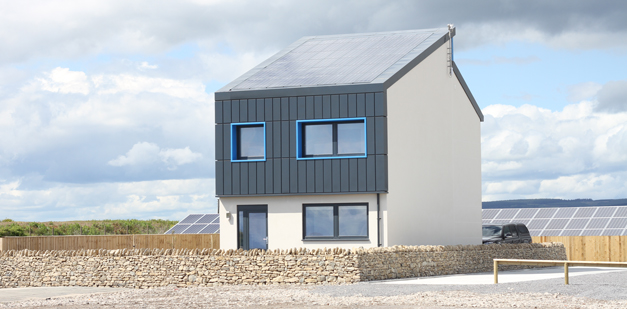SOLCER House
The Welsh School of Architecture designed and built The SOLCER House on the site of Cenin Renewables Ltd in Pyle, near Bridgend in Wales.
The house took 16 weeks to construct and was completed in February 2015 as part of the Wales Low Carbon Research Institute's (LCRI) SOLCER project, supported by SPECIFIC at Swansea University.
It is believed to be the UK's first purpose-built, low-cost energy smart house. It combines reduced energy demand, renewable energy supply and energy storage to create an energy positive house that exports more energy to the grid than it uses.
It was intended to be a prototype to meet the zero-carbon homes standard that had been due to be introduced by the government in 2016. However, in July 2015, the government published ‘Fixing the foundations’ a plan for growth, in which it stated it did not intend to proceed with the zero carbon allowable solutions carbon offsetting scheme, or the proposed 2016 increase in on-site energy efficiency standards. The EU requirement for ‘Nearly zero-energy buildings’ by 2018 (new public buildings) and 2020 (other new buildings) remains in place although it is not clear what standard of construction this will require in the UK.
Zero carbon homes were intended to use a combination of fabric efficiency, low energy technologies, and on-site and off-site renewable energy generation resulting in a house in which there were no carbon emissions from regulated energy (space heating, hot water, lighting and ventilation).
The SOLCER house is based on the 'Buildings as Power Stations' concept developed by the SPECIFIC Innovation and Knowledge Centre, but incorporates additional features developed by the LCRI's Low Carbon Buildings Research Programme.
It has high levels of thermal insulation and low air leakage and uses low-carbon cement, structural insulated panels (SIPS), external insulated render, transpired solar collectors and low-emissivity double glazed aluminium clad timber frame windows and doors.
The south facing roof includes glazed, solar photovoltaic panels which also allow the roof space below to be naturally lit. Solar generation and battery storage are used to power heating, ventilation, hot water and electrical power systems which includes appliances, LED lighting and heat pump. A solar air system preheats ventilation air which is topped up from a thermal water store.
Professor Phil Jones, head of the SOLCER project team at the Welsh School of Architecture said, "Now the house has been built our key task is to ensure that all of the measures that we have put in place are monitored to ensure the most energy efficient use. We will use this information to inform future projects with the aim of ensuring that Wales remains at the heart of the development of a zero carbon housing future. The building demonstrates our leading edge low carbon supply, storage and demand technologies at a domestic scale which we hope will be replicated in other areas of Wales and the UK in the future."
Economy Minister Edwina Hart said: "The Welsh and UK Governments – and governments across the EU – have set targets for very low 'nearly zero' energy buildings by 2020, and zero carbon new housing can deliver this and more.”
Kevin Bygate, Chief Executive of SPECIFIC, said: "Buildings that can generate, store and release their own renewable energy could be a game-changer. The SOLCER House is intentionally built with the best off-the-shelf, affordable technologies, so it proves what's possible even now – and there's plenty more technology in the pipeline."
[edit] Find out more
[edit] Related articles on Designing Buildings Wiki.
- Display energy certificate.
- Emission rates.
- Energy Act.
- Energy performance certificate.
- Energy Performance of Buildings Directive.
- Energy related products regulations.
- Fixing the foundations.
- Nearly zero-energy building.
- Performance gap.
- Simplified Building Energy Model.
- Zero carbon homes.
- Zero carbon non-domestic buildings.
Featured articles and news
RTPI leader to become new CIOB Chief Executive Officer
Dr Victoria Hills MRTPI, FICE to take over after Caroline Gumble’s departure.
Social and affordable housing, a long term plan for delivery
The “Delivering a Decade of Renewal for Social and Affordable Housing” strategy sets out future path.
A change to adoptive architecture
Effects of global weather warming on architectural detailing, material choice and human interaction.
The proposed publicly owned and backed subsidiary of Homes England, to facilitate new homes.
How big is the problem and what can we do to mitigate the effects?
Overheating guidance and tools for building designers
A number of cool guides to help with the heat.
The UK's Modern Industrial Strategy: A 10 year plan
Previous consultation criticism, current key elements and general support with some persisting reservations.
Building Safety Regulator reforms
New roles, new staff and a new fast track service pave the way for a single construction regulator.
Architectural Technologist CPDs and Communications
CIAT CPD… and how you can do it!
Cooling centres and cool spaces
Managing extreme heat in cities by directing the public to places for heat stress relief and water sources.
Winter gardens: A brief history and warm variations
Extending the season with glass in different forms and terms.
Restoring Great Yarmouth's Winter Gardens
Transforming one of the least sustainable constructions imaginable.
Construction Skills Mission Board launch sector drive
Newly formed government and industry collaboration set strategy for recruiting an additional 100,000 construction workers a year.
New Architects Code comes into effect in September 2025
ARB Architects Code of Conduct and Practice available with ongoing consultation regarding guidance.
Welsh Skills Body (Medr) launches ambitious plan
The new skills body brings together funding and regulation of tertiary education and research for the devolved nation.
Paul Gandy FCIOB announced as next CIOB President
Former Tilbury Douglas CEO takes helm.
UK Infrastructure: A 10 Year Strategy. In brief with reactions
With the National Infrastructure and Service Transformation Authority (NISTA).























